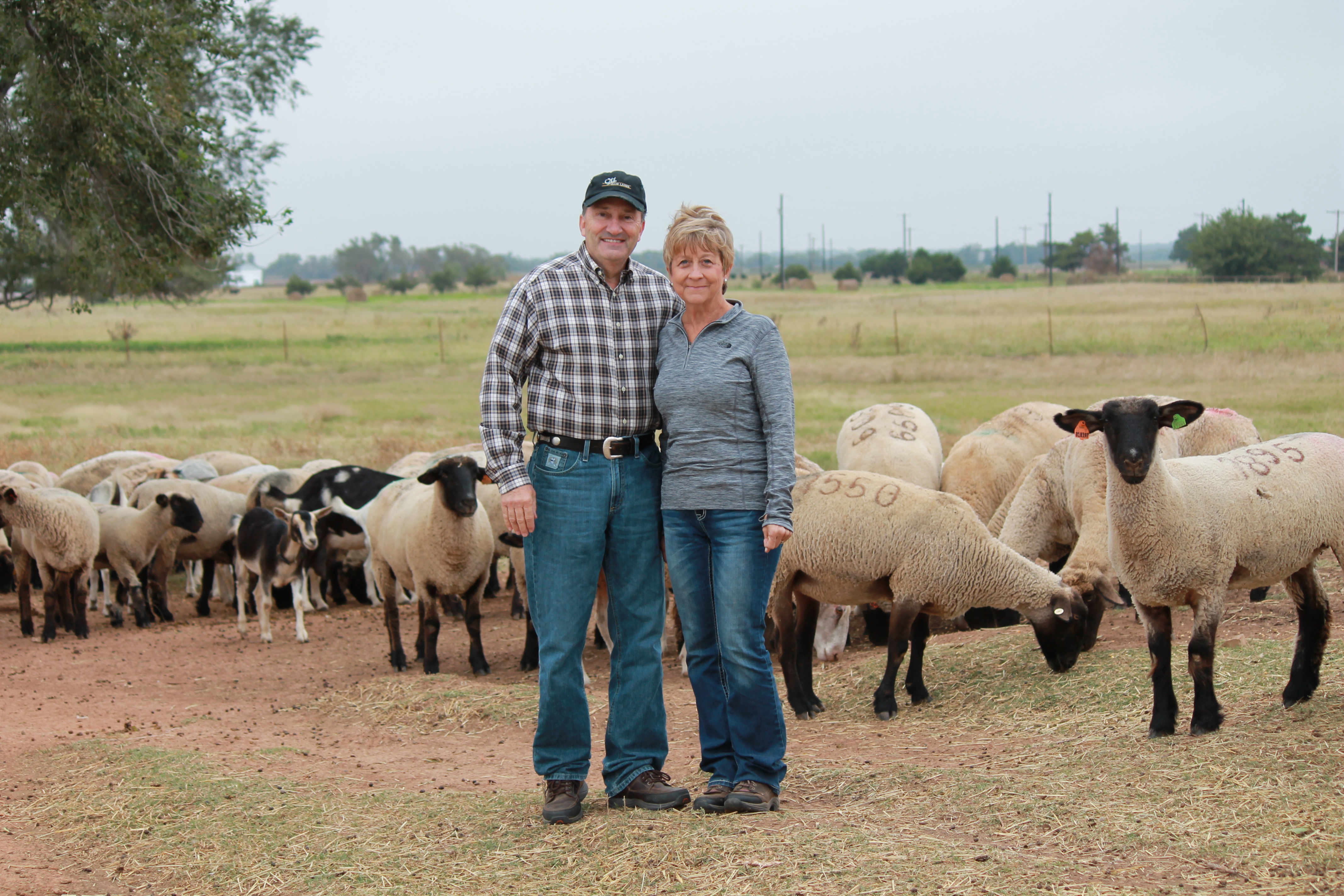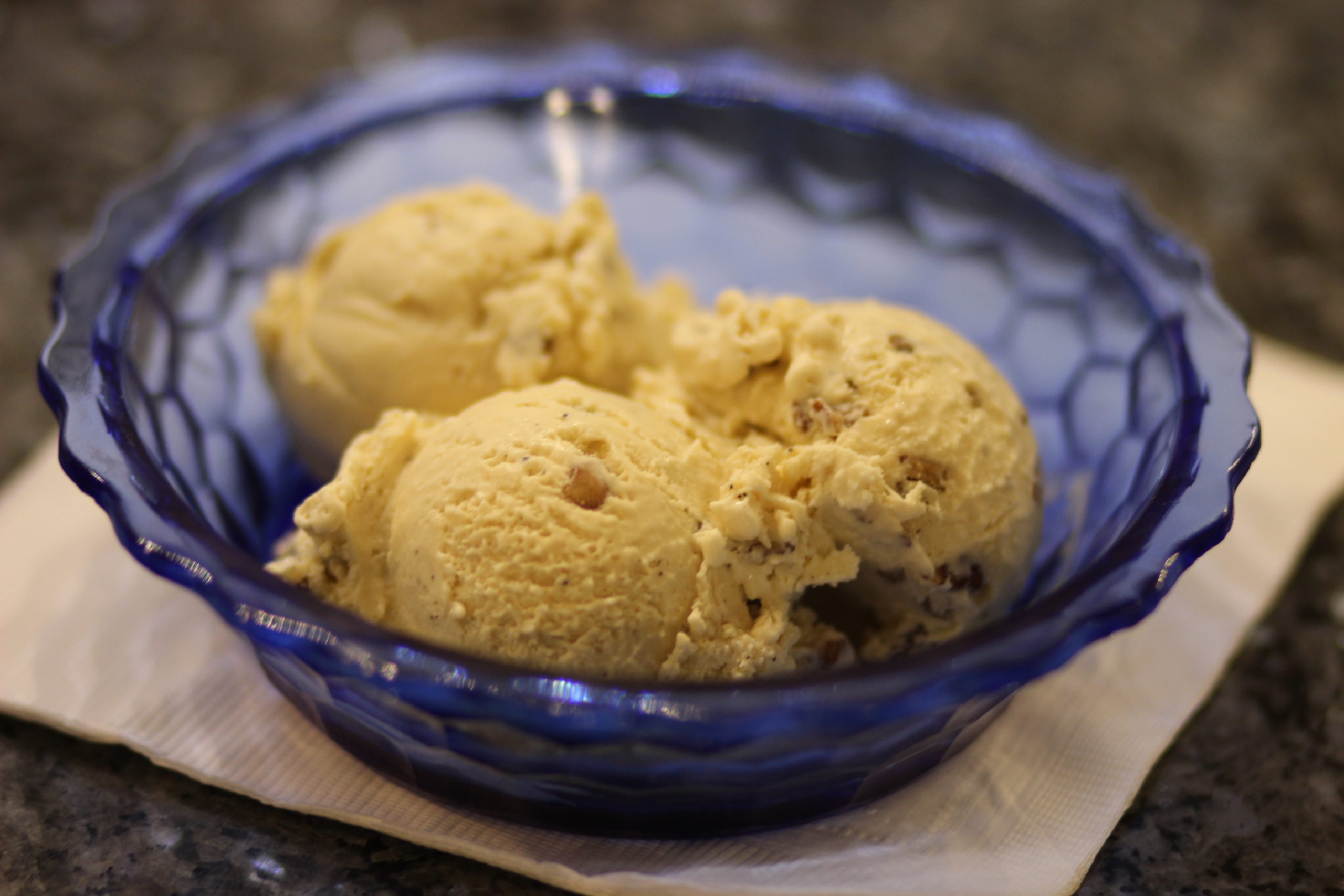Home
Decades of Distinction

Trophies and awards line shelves of rooms, while win photos cover the walls. In the barn, sale posters showcasing former winners from some of the largest events in the country and state surround the feed rooms. Over the years, breeding and selling high-quality show lambs has become the norm for Brad and Deb Ott of Fairview, Okla.
But that hasn’t always been the case.
In 1989, the Ott’s oldest daughter Robyn was in 4-H. While Deb had grown up riding and training horses, Brad had a background in show cattle. “I think the original plan was for me to show cattle, but I was just a little girl. My sister Kami was two years younger than me, so we thought we better start with sheep instead of cattle,” Robyn explained.
While new to showing lambs, the Otts knew what quality of livestock they wanted. Along with showing the Grand Champion Steer at the National Western Livestock Show in Denver, Colo., while in high school, Brad was also on the National Champion 4-H Livestock Team in high school, and the Northwestern Oklahoma State Livestock Judging Team his freshman and sophomore years of college and the Kansas State University Livestock Judging Team his junior and senior years in college. Jhhh i
While Deb didn’t have a background in livestock shows, she and her twin sister Diana grew up training horses.
“We had raised cattle and horses, but when we moved to Fairview we didn’t have enough land at that time to raise them. We started with the lambs because of the kids,” Deb said.
After several lamb sales where the ones they wanted to purchase went for more money than they were willing to spend, Brad and Deb decided that breeding their own lambs would be the best course of action.
At the time, an area agriculture education instructor was going out of the lamb business and sold the Otts 18 ewes. “They were nice ewes. They weren’t great, but we put them with a very, very good buck,” Deb said. The family took the first set of lambs to a local lamb sale, but didn’t receive a single bid, and had to take the lambs home.
“We understood it was part of paying our dues,” noted Deb. “Other breeders and buyers need to learn to be able to trust you and know your lambs are quality.”
Brad and Deb knew they were on the right track, and while several of the lambs were nice, one was extra special. Not long after that first sale, Robyn made the premium sale at the Tulsa State Fair. “It took a while to get the program up and running,” Robyn recalled. “But by the time I was in high school we were winning more than we were losing. It was very rewarding, especially knowing that we were doing it the right way. That’s something my parents have always felt strongly about. If it was illegal, immoral, or unethical, we wouldn’t do it, even though we’re all very competitive.”
Soon, Robyn, her little sister Kami, and eventually younger brother Cody were winning at all the major events.
Robyn amassed the Reserve Grand Champion Lamb at the NAILE in Louisville, Kentucky, and Grand Champion Lamb at the Oklahoma State Fair and had breed champions at the Tulsa State Fair and OYE.
Kami, also an accomplished showman, won the American Royal in 1998, and the following year, at 17 years old won the Reserve Grand Champion at the Oklahoma Youth Exposition and also the Grand Champion Lamb at the Northwest District Livestock Show. Tragically, shortly after those wins Kami was killed in a car accident. Now, the OYE Reserve Grand Lamb Traveling Trophy and local FFA Kami Ott Leadership Award are given annually in her honor.
“By the time Cody was competing, we had our program figured out,” Deb said. “He was also an excellent showman.” With winning Grand Champion Lamb at The Tulsa State Fair, Grand Champion Lamb at the Oklahoma State Fair, Bronze Medallion Lamb at OYE and was the premier exhibitor at the Denver National Western Market Lamb Show, Cody also won the American Royal three times. One of those wins, in 2004, was even more special than others, because his cousin Travis Stroble won Reserve Grand – and both lambs were from the Ott’s program!
“I was the youngest, so my sisters were kind of the guinea pigs, and were able to learn a lot about showing. By the time I came along we were rocking and rolling, and I was able to just hit the ground running,” Cody said. “I’m so thankful to my sisters and my parents for that because I don’t think I would have been able to do what I had done if it weren’t for them.”
Once Cody was done showing, the Otts had to decide: sell out or continue selling lambs. “It was a good business, and we loved it. It’s hard to give up something you enjoy,” Deb said. “I don’t want to retire.”
Brad added, “She’s never going to give it up. I like it, but she loves it. If she’s not doing something 24 hours a day, she’s not happy. Staying active is a good way to enjoy life.”
Learn more about Brad and Deb Ott in the November issue of Oklahoma Farm & Ranch.
Home
Simple and Effective Ways to Reduce Reliance on Public Utilities

In today’s world, our reliance on public utilities such as electricity, water, and natural gas is undeniable. However, there is a growing movement towards greater self-sufficiency and sustainability. Many people are exploring ways to reduce their dependence on these public services, both to save money and to contribute to a more sustainable future. In this article, we’ll discuss some simple yet effective ways to reduce reliance on public utilities.
1. Generate Your Own Electricity
Generating your own electricity is one of the most significant steps towards reducing reliance on public utilities. Here are some options to consider:
Solar Panels: Installing solar panels on your roof or property can harness the power of the sun to generate electricity. Solar energy systems can provide a significant portion of your electricity needs and often come with government incentives and tax benefits.
Wind Turbines: If you have a suitable location, small wind turbines can generate electricity from wind power. Wind energy can be an excellent complement to solar panels, especially in windy areas.
Backup Generators: While not a primary source of electricity, backup generators, such as those powered by propane or natural gas, can provide power during outages and reduce your reliance on the grid.
2. Use Energy-Efficient Appliances
Upgrading to energy-efficient appliances can significantly reduce your electricity consumption. Look for Energy Star-rated appliances, LED lighting, and smart thermostats that help you manage and reduce energy use.
3. Invest in Insulation and Weatherization
Proper insulation and weatherization of your home can help maintain a comfortable temperature year-round, reducing the need for heating and cooling. Seal gaps and cracks in your home’s structure, add insulation in attics and walls, and consider energy-efficient windows and doors.
4. Collect Rainwater
Installing a rainwater harvesting system allows you to collect and store rainwater for non-potable uses, such as watering your garden or flushing toilets. This reduces your reliance on municipal water supplies, especially during droughts.
5. Compost and Reduce Food Waste
Reducing food waste not only saves money but also reduces the energy and resources needed to produce and transport food. Composting kitchen scraps and yard waste can help enrich your soil, reducing the need for chemical fertilizers.
6. Install Low-Flow Fixtures
Low-flow showerheads, faucets, and toilets can significantly reduce water usage without sacrificing functionality. These fixtures reduce water bills and ease the demand on public water supplies.
7. Practice Off-Peak Energy Use
Many utility companies offer off-peak rates, where electricity is cheaper during specific hours. Shift energy-intensive tasks like laundry and dishwashing to these off-peak hours to save money.
8. Reduce Water Heater Temperatures
Lowering the temperature of your water heater can reduce energy consumption. Most households don’t need scalding hot water, and a moderate temperature is often sufficient for daily use.
9. Switch to Propane or Natural Gas
In some cases, switching to propane or natural gas appliances can be more energy-efficient and cost-effective than electric alternatives. For example, propane-powered stoves and water heaters can provide efficient heating.
10. Install Energy-Efficient Windows and Doors
If you’re considering home renovations, invest in energy-efficient windows and doors. These can better insulate your home, reducing the need for heating and cooling.
11. Create an Energy-Efficient Landscape
Planting trees and shrubs strategically around your home can provide shade in the summer and windbreaks in the winter, reducing the need for heating and cooling.
12. Learn Basic Home Repairs
Knowing how to perform basic home repairs can help you maintain your home’s systems more efficiently. Simple tasks like fixing leaky faucets, insulating pipes, and sealing drafts can make a significant difference.
13. Consider Alternative Transportation
Reducing your reliance on public utilities extends to your transportation choices. Consider walking, biking, carpooling, or using public transportation to reduce fuel consumption and emissions.
14. Invest in Energy Storage
Battery technology has advanced, making it possible to store excess electricity generated by solar panels or wind turbines. These batteries can provide power during outages or during peak demand times when electricity prices are high.
15. Educate Yourself
Staying informed about energy-efficient practices and technologies is essential. Consider taking courses, attending workshops, or reading books and articles on sustainability and self-sufficiency.
Reducing reliance on public utilities is a journey that involves a combination of lifestyle changes, home improvements, and technology adoption. While it may not be feasible or practical for everyone to completely disconnect from public services, even small steps can lead to significant reductions in utility bills and environmental impact. Whether you choose to generate your own electricity, conserve water, or practice energy-efficient habits, every effort contributes to a more sustainable and self-reliant future. Ultimately, these changes not only benefit your wallet but also help preserve our planet for future generations.
Home
Butter Pecan Ice cream

Total Time: 4 hours
Yields: 1 1/2 Quarts
- Ice cream base:
- 6 large egg yolks
- 6 tablespoons unsalted butter
- 1 cup brown sugar
- 1/4 teaspoon salt
- 2 cups heavy cream
- 2 cups whole milk
- 1 teaspoon vanilla extract
- Pecans:
- 1 cup pecans
- 1 tablespoon unsalted butter
- Pinch salt
- Instructions:
- In a medium sized heat-safe bowl, whisk together the egg yolks until well blended. Add brown sugar and salt and mix until incorporated. Set aside.
- Pour the cream into a metal bowl set in a larger bowl of ice and set a medium-mesh sieve on top. Set aside.
- In a medium, heavy-bottomed saucepan on medium heat, melt the butter and cook it, stirring constantly, until it just begins to brown.
- Slowly add the milk, stirring to incorporate. It will foam up initially, so make sure you are using a pan with high enough sides. Do not let boil or the mixture may curdle.
- To temper the eggs, slowly pour half of the milk and butter mixture into the eggs, whisking constantly to incorporate.
Then add the warmed egg mixture back into the saucepan with the remaining milk and butter mixture.
- Stir the mixture constantly over medium heat with a wooden or heatproof rubber spatula, scraping the bottom as you stir, until the mixture thickens and coats the spatula, about 5-7 minutes.
- Add vanilla and stir until cool over the ice bath. Chill thoroughly in the refrigerator.
- While the mixture is chilling, preheat the oven to 350°F. Melt 1 tablespoon of butter. Toss with pecans and a pinch of salt. Spread pecans out on a rimmed baking sheet and bake at 350°F for 10 minutes, until the pecans are lightly toasted. Set aside to cool. Once cool, roughly chop the pecans and set aside.
- Once the ice cream mixture is thoroughly chilled, churn in your ice cream maker according to the manufacturer’s instructions.
- Once the ice cream has been formed in the ice cream maker, it will be fairly soft. Fold in the chopped pecans.
- Put in an airtight plastic container and place in the freezer for at least an hour, preferably several hours. If it has been frozen for more than a day, you may need to let it sit at room temperature for a few minutes to soften it before serving.
Home
Valentine’s Crack

Servings: 30
Total
Time: 13 minutes
- 50 Saltine Crackers
- 1 Cup butter cut into chunks to melt down, 2 sticks
- 1 Cup LIght Brown Sugar
- 2 Cups White Chocolate Chips
- 1/4 Cup Pink Chocolate Melts
- Valentine’s Sprinkles
Ingredients:
- Preheat oven to 325 degrees. Line a large cookie tray with aluminum foil. Spray with cooking spray. Line saltines up neatly in rows.
- In a medium sized pot melt your butter and brown sugar. Once butter is melted down, bring to a boil. Continue to stir the entire time and boil for about 2 minutes. It will look bubbly and look like caramel.
- Pour over the top of the saltines. Gently spread across the saltines.
- Place in oven and bake for about 7 minutes.
- While in the oven melt your pink chocolate melts according to package directions.
- Remove the pan from the oven and then sprinkle your white chocolate chips over the saltines. Your hot toffee mixture will melt the chips. You can put it back in the oven for a minute to move the process along. Once your chips are melting, spread across the top evenly with a spatula.
- Mix your pink chocolate into the white chocolate by pouring it over the top in a decorative way. You can use a knife tip to help combine colors to your liking. Quickly decorate with sprinkles, the melted chocolate will act as your glue.
- Once chocolate is completely hardened you are ready to serve.
-

 Country Lifestyle7 years ago
Country Lifestyle7 years agoJuly 2017 Profile: J.W. Hart
-

 Outdoors6 years ago
Outdoors6 years agoGrazing Oklahoma: Honey Locust
-

 Country Lifestyle2 years ago
Country Lifestyle2 years agoThe Two Sides of Colten Jesse
-

 Attractions7 years ago
Attractions7 years ago48 Hours in Atoka Remembered
-

 Farm & Ranch5 years ago
Farm & Ranch5 years agoHackberry (Celtis spp.)
-

 Outdoors4 years ago
Outdoors4 years agoPecan Production Information: Online Resources for Growers
-

 Equine7 years ago
Equine7 years agoUmbilical Hernia
-

 Country Lifestyle1 year ago
Country Lifestyle1 year agoSay Yes!




